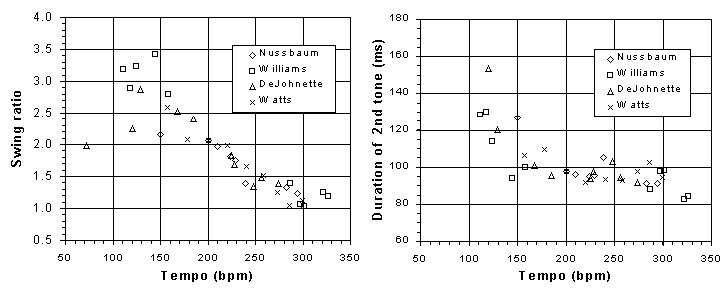Acoustical Society of America
ASA/EAA/DAGA '99 Meeting
Lay Language Papers
Jazz Drummers' Swing Ratio in Relation to Tempo
Anders Friberg, andersf@speech.kth.se
Andreas Sundström
Royal Institute of Technology
Dept. of Speech, Music and Hearing
SE-100 44 Stockholm
Sweden
Popular version of paper 5aMUb10
to tempo.
Presented Friday morning, March 19, 1999
ASA/EAA/DAGA '99 Meeting, Berlin, Germany
Introduction
Rhythm is one of the most important ingredients in jazz music. Jazz must "swing". An essential part of this is the rhythmic concept called "swing eighth note pattern". This means that eighth notes are performed in patterns of long-short-long-short. These uneven patterns not only occur in jazz but are also common in folk and popular music, as well as in classical Baroque music.
What is not known is the exact relation between the long and the short note. It is not specified in the score and music students are often advised to learn it by listening to recordings. Such knowledge would contribute to the understanding of the perception and production of music. It would also be useful for generating synthetic performances on a MIDI sequencer, as well as being helpful for students who wish to learn how to swing.
The purpose of this study was to measure the relation between the long and short note (henceforth swing ratio) for different tempi. We did this in two ways: (1) by measuring recorded performances of well-known drummers, and (2) by letting listeners adjust the swing ratio in a synthesized jazz performance.
1. Measurements of drummer's swing ratio
We focused here on the drummer's ride cymbal. This is an important contribution to the swing feel in a jazz ensemble. We used commercial "classic" jazz recordings of well-known drummers. The drummers were Tony Williams with the Miles Davis Quintet; Jack DeJohnette with the Keith Jarrett Trio, Jeff Watts with the Wynton Marsalis Quartet and Adam Nussbaum playing on an Aebersold Play-a-long CD.
The results indicate that the swing ratio varies considerably
for different tempi. This is illustrated in the left graph of Figure 1,
where each mark represents the swing ratio and tempo for each song on the
records. A swing ratio of 1 means that the eighth notes are of equal length
and a swing ratio of 2 means that the long eighth note is exactly twice
as long as the short eighth note. We see in the figure that for fast tempi,
the swing ratio reaches 1 and that for successively slower tempi, the swing
ratio gradually increases to almost 3.5. Note that the latter in musical
terms is more than a dotted eighth note followed by a sixteenth note. Interestingly,
these differences in swing ratio are not at all in agreement with the common
conception which states that the swing ratio is close to 2, also referred
to as "triple feel".
The right graph in Figure 1 contains the same data but
plotted differently. Here the vertical axis represents the duration of
the "short" note in milliseconds. It reveals that there is an approximately
constant duration of the "short" note of about 100 ms for medium to fast
tempi. This value coincides with the shortest notes used for a melodic
line in jazz. It is also in agreement with nerve response times both for
auditory and visual stimuli. All this indicates that in order for individual
tones to be perceived, they cannot be shorter then about 0.1 second.
2. Listeners' adjustment of preferred swing ratio
Here we measured the swing ratio according to the listeners
preference. By using computer-generated jazz trio performances, it was
possible to adjust the swing ratio to any value. A total of 34 listeners
were asked to adjust the swing ratio (without seeing the actual value)
to a musically optimal position. The music example was a performance of
the first eight bars of Charlie Parkers "Yardbird Suite". All instruments
were created from samples of real instruments.
The resulting swing ratio averaged over listeners is shown
in Figure 2. The same tendency as in the measurement of drummers is evident
with an increasing swing ratio for slower tempi and decreasing swing ratio
for faster tempi.

Figure 1. Swing ratio as a function of tempo (left)
and absolute duration of "short" note as a function of tempo (right) for
the four drummers and all excerpts. Each mark represents an average from
each song. Observe that the slowest excerpt by DeJohnette (72 bpm) is outside
the range of the right graph (duration of 2nd note = 416 ms).

Figure 2. Listeners preferred swing ratio as a function of tempo. The bars indicate 95% confidence intervals.
Conclusion
The swing ratio (i.e. the ratio between two subsequent eighth notes) was found to vary substantially with tempo. The common conception among musicians that the swing ratio is close to 2 (the first note is twice as long as the second) was not confirmed. On the contrary, the duration of the second note was found to be constant at about 0.1 seconds for medium to fast tempi. This indicated that the second note had reached a limit of tone duration that corresponded to the shortest tone that can be individually perceived within a melodic line.
Sound examples
Synthesized examples of different swing ratios are found
here:
http://www.speech.kth.se/music/performance/Texts/inegales.htm